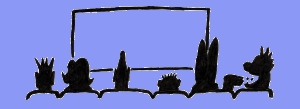Using Symbolism in AV
Once I get an idea for an AV I like to write some sort of script before I select the images. The storyline may be the result of intensive research but often it comes from something that has caught my attention and intrigued me. I try to write the script without thinking about the images. If I don't, I find it disturbs any creative flow I have as my mind would start wandering, wondering how I was going to illustrate what I had just written! Therefore, finding images to go with my script is sometimes quite a challenge but actually quite fun! Obviously you do need to have the key shots but it is amazing what can be used to get a meaning across!
The one thing to remember is that every image fits visually into the sequence and (hopefully) doesn't come across as 'naff'. Most friends will tell you what they think if you ask them! It usually helps if the images are taken on location. So, while you are out taking the main shots, have a few thoughts in you head about what you want to illustrate and you might spot something that could work. Better still, if you already know the images that will go either side of your 'symbolic' ones then you can also work out the best angles to get good dissolves.
|
The first AV I made with Ron Davies (Linda, his wife was also a co-author)
was called Cariadon. It is a legend about St. Dwynwen the Patron
Saint of Welsh Lovers. As this was set way back in time we didn't want to
use real people in it. We tried out various ideas and came up with shadows.
This worked really well as it left our audience to interpret how the characters
would look, something we are used to doing when reading a book. We also had a
rape scene in it. This turned out to be less difficult to illustrate than we
first thought! LLanddwyn Island, where St. Dwynwen lived, has some wonderfully
shaped and coloured rocks. We built the tension up with jagged rocks and
'jagged' music from 'The Protecting Veil' (John Tavener) and we used suitably shaped rocks and
patterns behind the descriptive narrative of the script.
| ||
 Shadows from Cariadon |
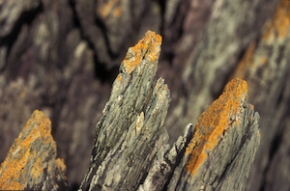 Jagged rocks 1 from Cariadon |
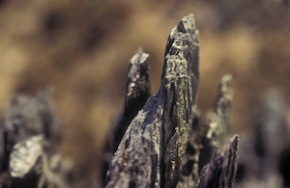 Jagged rocks 2 from Cariadon |
|
In our sequence Gelert, whilst out on location, we had spotted a black crow sitting on a branch. This we used, along with the appropriate music, to indicate unease and foreboding. In another part of the sequence we used a very prickly bit of gorse bush when we talked about fighting. The sharp spikes suggesting daggers and swords. One of my favourite shots is one taken by Ron of the delicate flowers on some grass laden with dew. We used this to indicate great sadness.
| ||
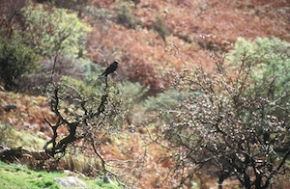 Black crow symbolising foreboding from Gelert |
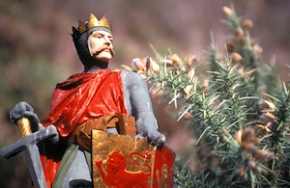 Gorse to symbolise the prince as a warrior |
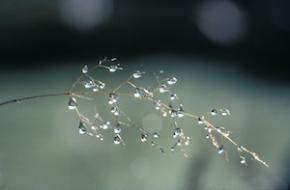 Used to indicate great sadness in Gelert |
| Ron is a master of symbolism and taught me a great deal. One of the things is that it doesn't have to be 'in your face' obvious. Subtlety is sometimes best as it's important not to interrupt the flow of the sequence. This does mean that not everybody will spot the meaning straight away, some people are more tuned in to it than others! In my sequence It's all down to the Packaging I used rough seas breaking over rocks when I talked about Lord Leverhulme being in turmoil, a sparse tuft of grass for the islanders living a scant existence and rocks in the sand when I talked about the people being embedded in the area. A large piece of seaweed pointing out to sea illustrated people leaving the island with the footprint that was already there, turned in Photoshop to point towards the sea.
| ||
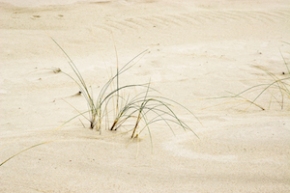 Illustrating a scant existence from Packaging |
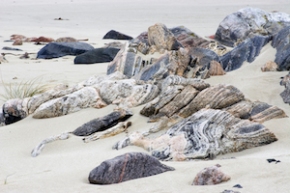 Illustrating a sense of belonging, of family |
 Seaweed pointing out to sea from Packaging |
Symbolism has always been a major factor in many works of art. We have just visited the Picasso Exhibition at the Tate Liverpool, his work uses symbolism on many levels. Some of the meanings were fairly obvious, his Dove of Peace is possibly one of the most famous symbols of all time. For me, most of his work did need the accompanying written explanation because they were painted for a specific reason at a specific time. Once read, I saw the paintings in a totally different light! Fortunately in our AVs we have the benefit of a sound track and the other images to help get our meaning across.
So with a little thought, the use of symbolism can add a bit of subtlety, perhaps a bit of mysticism and what can often turn out to be the odd bit of magic to our sequences!
Marion Waine July 2010

